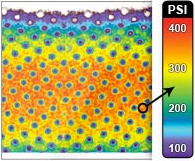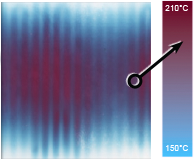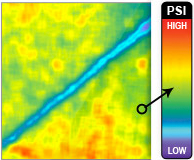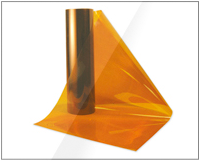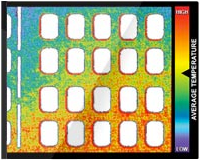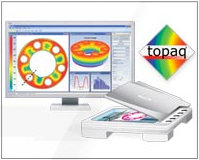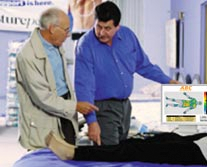Process Characterization Aided by Pressurex® Diagnostic Sensor Film
Developed and sold by Sensor Products Inc., of Madison NJ, USA, is the force-indicating Mylar film Pressurex® . The films change color permanently and instantly in response to the applied pressure and the resultant patterns of different shades of pink may be compared to a color calibration chart to reveal actual contact pressure and magnitude.
Additionally, an optical analysis system called Topaq, consisting of a proprietary scanner and software, can be used to image and interpret the pattern of stress marks on the film. From this the system provides highresolution, colour-calibrated images and thereby a wealth of statistical information from the analysed film (as shown in provided images).
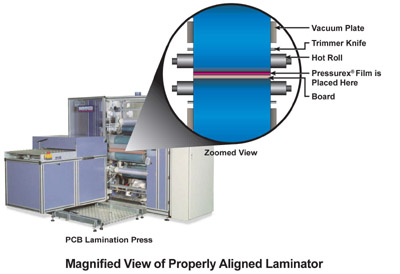
For example, the distribution and actual magnitude of pressure between any contacting or impacting surfaces, including pressure statistics for regions of interest, average force, 3d images, histograms, line charts, etc., such as PCB flatness. It will provide quantitative data as to where the greatest force occurs or show unevenness in the lamination. Accuracy is +/-10% by eye or +/-1% via the optical measurement system.
Of course, the user can simply examine by eye the resultant color changes, make process changes and repeat until optimal distribution is achieved. Alternatively, a variety of imaging systems can be used to record, archive or share results for ongoing QC such as six-sigma statistical process monitoring.
Pressurex® is only 100-200 µm thick so it will conform to curved surfaces, for example. It will not contaminate surfaces under scrutiny and suits invasive-intolerant environments. This it is applicable for maintenance and diagnostic procedures from R&D through process development and manufacturing lines.

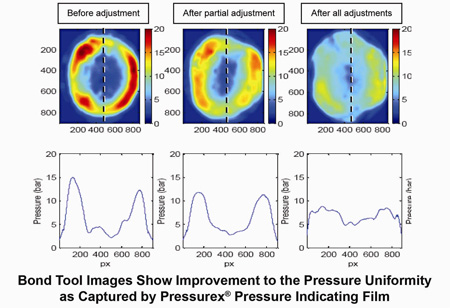
Topaq Pressure Analysis System has broad application wherever pressure is of interest. However, here we focus specifically on some examples of its usefulness in microelectronics. Sensor Products has two decades of experience in the exclusive application of pressure monitoring and analysis. Topaq has proven to be the solution preferred by many engineers thanks to its accuracy and convenience; it can measure pressure from 2 - 43,200 psi (0.14 - 3,000 kg/cm2). Unlike finite element analysis, Topaq is a postprocess interpretative system that can collect data via a proportional tactile transducer in just minutes. It comprises a specially calibrated densitometric scanner and Windows-based software.
Applications
Applications for this characterisation approach are limited only by the imagination of the users. In microelectronics this includes transistor mounting, gasketing, TAB, LCDs, wafer-to-wafer bonding, solder paste, photoresist and other films as well as the welding and sealing of packages.
It has been applied to the manufacture of hybrid circuits whereby the film has helped reveal inconsistencies in resistor thickness across large area substrates. Similarly, uniformity problems have been clearly revealed during thermocompression in the TAB process and the design of heat sinks. Additional uses include pressure determination during the stack insertion process of transducer manufacturing, core pressure in wound electrolytic capacitors, and the lamination process of ceramic capacitors.
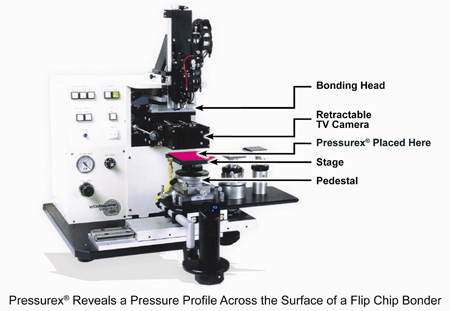
Visitors to the Pressurex® website can also read of other examples such as the collaboration between Micralyne Inc., Nanochip Inc., and Intel Corp. These partners have used Pressurex® to study the effect of various types of seed metallization in a Au/Sn eutectic wafer bond. From the range of bond parameters and metals studied, it was established that the Nb/Au combination produced the best overall results. It showed good mechanical strength, liquid proof seal and no spill-outs. The team concluded that the effective way to produce well defined gaps after bonding was to use silicon dioxide standoffs.
In a recent article, the efficacy of using Pressurex® film for wafer bonding has been transfer to its potential use for bonding of flip chips.
Finally, in the lamination of printed circuit boards, Sensor Products, headed by founder Jeffrey Stark, has been assessing how to achieve optimal contact between the resist and the substrate surface by making the resist flow to conform to the surface topography. The flow was achieved by lowering the resist viscosity by heating and by applying a pressure differential. They observed that insufficient pressure and/or non-uniform pressure could lead to lamination defects. In order to measure nip pressure magnitude and uniformity Pressurex® film was used to quantify the actual force profile at the interface of the roller set. They could observe directly in the image captured by the film both the pressure distribution and magnitude or ‘footprint’.
Pressurex® film is a quick, accurate and economical way to detect and correct pressure variations in the lamination of dry film resist to the board substrate. When placed between nip rollers in the lamination press, the film instantaneously and permanently changes color directly proportional to the actual pressure applied. With Pressurex®, variations in pressure that can lead to defects are easily detected and corrected—decreasing scrap, improving yield, and increasing productivity. Even, consistent bonding of the thin layer of photoresist is critical to the board’s subsequent electrical performance. The photoresist material is placed on the board’s surface using a hot roller system. If the rollers do not exert uniform pressure across the board’s surface, the thin photoresist layer can fail to adhere, bubble or even wrinkle during the process. This causes electrical instability and possible failure of the resulting board.
Pressurex® can reduce lamination defects by ensuring alignment and parallelism of the rollers. The film is placed between two rollers before closing the nip and applying pressure. Instantly a pseudo color map of pressure magnitude and distribution is revealed. The precise pressure magnitude is easily determined by comparing color variation results to a color correlation chart (conceptually similar to interpreting Litmus paper).




